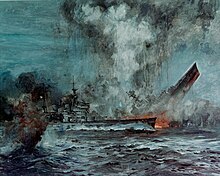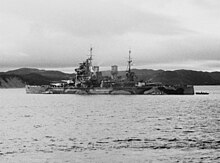HMS Prince of Wales (53)
HMS Prince of Wales was a King George V-class battleship of the Royal Navy that was built at the Cammell Laird shipyard in Birkenhead.
Despite being sunk less than a year after she was commissioned, Prince of Wales had an extensive battle history, first seeing action in August 1940 while still being outfitted in her drydock, when she was attacked and damaged by German aircraft.
In the aftermath of the First World War, the Washington Naval Treaty was drawn up in 1922 in an effort to stop an arms race developing between Britain, Japan, France, Italy and the United States.
[3] The water was pumped out through the joint efforts of a local fire company and the shipyard, and Prince of Wales was later dry-docked for permanent repairs.
[11] On 22 May 1941, Prince of Wales, the battlecruiser Hood and six destroyers were ordered to take station south of Iceland and intercept the German battleship Bismarck if she attempted to break out into the Atlantic.
Captain John Leach knew that main-battery breakdowns were likely to occur, since Vickers-Armstrongs technicians had already corrected some that took place during training exercises in Scapa Flow.
His battle plan called for Prince of Wales and Hood to concentrate on Bismarck, while the cruisers Norfolk and Suffolk would handle Prinz Eugen.
Prince of Wales, with thicker armour, was less vulnerable to 15-inch shells at ranges greater than 17,000 feet (5,200 m), but her crew had also not been trained to battle efficiency.
Prinz Eugen, with Bismarck astern, had Prince of Wales and Hood slightly forward of the beam, and both ships could deliver full broadsides.
Prince of Wales made a sharp starboard turn to avoid hitting the debris and in doing so further closed the range between her and the German ships.
Augusta proceeded from Massachusetts to Placentia Bay and Argentia in Newfoundland with the cruiser USS Tuscaloosa and five destroyers, arriving on 7 August while Potomac played a decoy role by continuing to cruise New England waters as if the president were still on board.
[25] At Placentia Bay, Newfoundland, Roosevelt transferred to the destroyer USS McDougal to meet Churchill on board Prince of Wales.
Prince of Wales, the battleship Rodney and the aircraft carrier Ark Royal were despatched to intercept, but the search proved fruitless.
[24] On 25 October Prince of Wales and a destroyer escort left home waters bound for Singapore, there to rendezvous with the battlecruiser Repulse and the aircraft carrier Indomitable.
Calling at Freetown and Cape Town South Africa to refuel and generate publicity, Prince of Wales also stopped in Mauritius and the Maldive Islands.
[28] Admiral of the Home Fleet Sir John Tovey was opposed to sending any of the new King George V battleships as he believed that they were not suited to operating in tropical climates.
A signal was received from the Admiralty in London ordering the British squadron to commence hostilities, and that evening, confident that a protective air umbrella would be provided by the RAF presence in the region, Admiral Phillips set sail.
Force Z at this time comprised the battleship Prince of Wales, the battlecruiser Repulse, and the destroyers Electra, Express, Tenedos and HMAS Vampire.
Eight Type 96 "Nell" bombers dropped their bombs close to Repulse, one passing through the hangar roof and exploding on the 1-inch plating of the main deck below.
[29] At 13:15 the order to abandon ship was given, and at 13:20 Prince of Wales capsized to port, floated for a few brief moments upside down, and sank stern first;[29] Admiral Phillips and Captain Leach were among the 327 fatalities.
It is often pointed out, however, that contributing factors to the sinking of Prince of Wales were her surface-scanning radars being inoperable in the humid tropic climate, depriving Force Z of one of its most potent early-warning devices, and the critical early damage she sustained from the first torpedo.
Further electrical failures left parts of the ship in total darkness, and added to the difficulties of her damage repair parties as they attempted to counter the flooding.
[33] The sinking was the subject of an inquiry chaired by Mr. Justice Bucknill, but the true causes of the ship's loss were only established when divers examined the wreck after the war.
The Director of Naval Construction's report on the sinking claimed that the ship's anti-aircraft guns could have inflicted heavy casualties before torpedoes were dropped, if not preventing the successful conclusion of attack had crews been more adequately trained in their operation.
The ship's bell was manually raised in 2002 by British technical divers with the permission of the Ministry of Defence and blessing of the Force Z Survivors Association.
It was restored, then presented for display by First Sea Lord and Chief of Naval Staff, Admiral Sir Alan West, to the Merseyside Maritime Museum in Liverpool.
The expedition's findings sparked considerable interest among naval architects and marine engineers around the world; as they detailed the nature of the damage to Prince of Wales and the exact location and number of torpedo strike holes.
In October 2014, the Daily Telegraph reported that both Prince of Wales and Repulse were being "extensively damaged" with explosives by scrap metal dealers.
Cammell Laird were able to contact Utley Offshore in St Helens, the foundry that made the original bell and that of RMS Titanic, which still had the pattern based on the 1908 Admiralty design.
Cammell Laird COO Tony Graham presented the finished replica to commanding officer Captain Darren Houston during the ship's week-long visit to Liverpool in March 2020.









